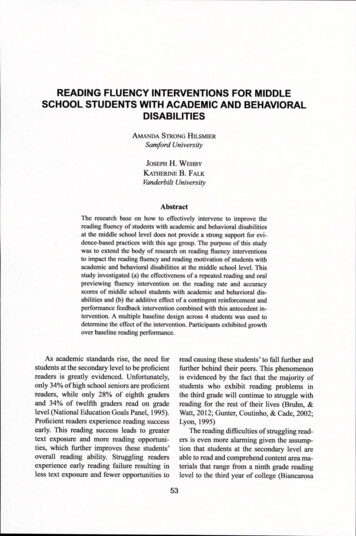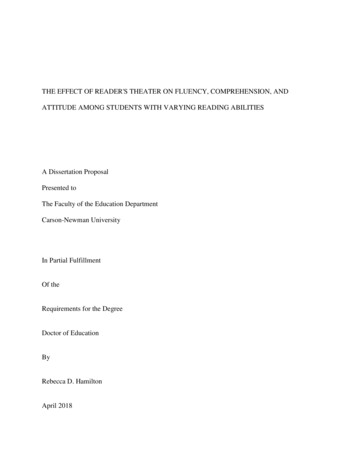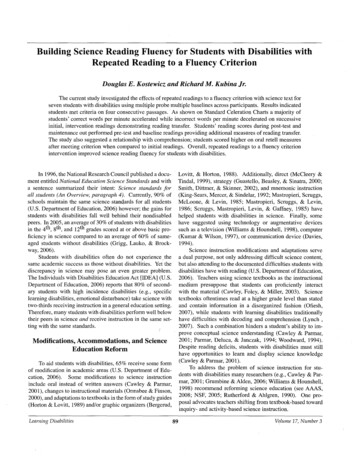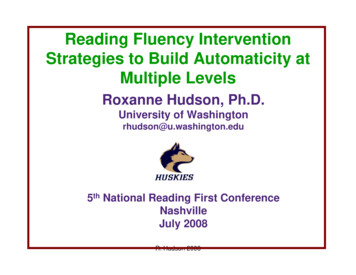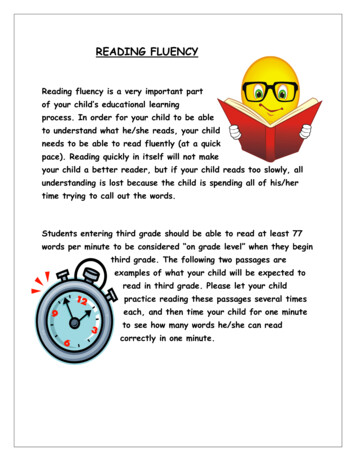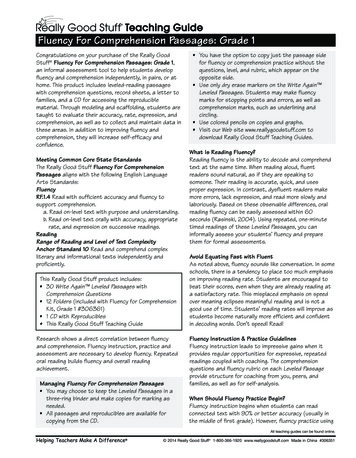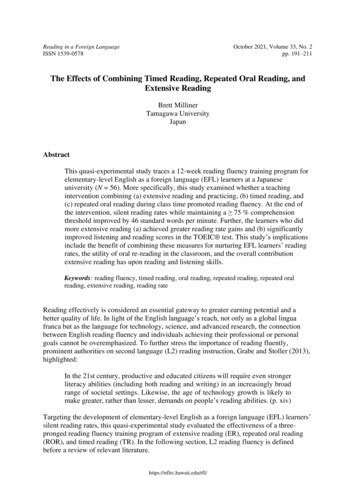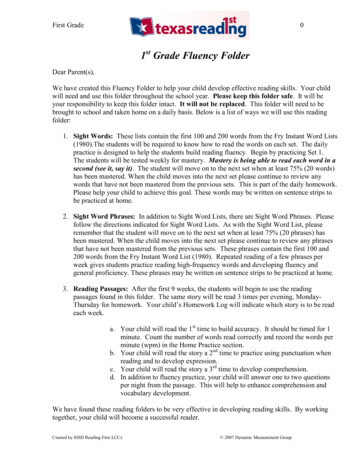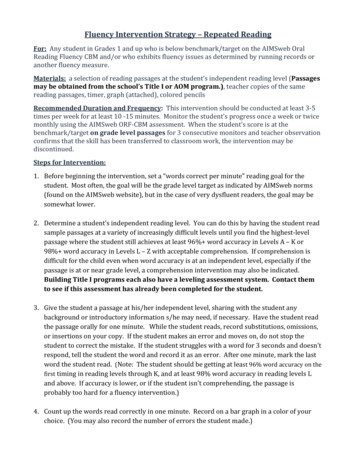
Transcription
Fluency Intervention Strategy – Repeated ReadingFor: Any student in Grades 1 and up who is below benchmark/target on the AIMSweb OralReading Fluency CBM and/or who exhibits fluency issues as determined by running records oranother fluency measure.Materials: a selection of reading passages at the student’s independent reading level (Passagesmay be obtained from the school’s Title I or AOM program.), teacher copies of the samereading passages, timer, graph (attached), colored pencilsRecommended Duration and Frequency: This intervention should be conducted at least 3-5times per week for at least 10 -15 minutes. Monitor the student’s progress once a week or twicemonthly using the AIMSweb ORF-CBM assessment. When the student’s score is at thebenchmark/target on grade level passages for 3 consecutive monitors and teacher observationconfirms that the skill has been transferred to classroom work, the intervention may bediscontinued.Steps for Intervention:1. Before beginning the intervention, set a “words correct per minute” reading goal for thestudent. Most often, the goal will be the grade level target as indicated by AIMSweb norms(found on the AIMSweb website), but in the case of very dysfluent readers, the goal may besomewhat lower.2. Determine a student’s independent reading level. You can do this by having the student readsample passages at a variety of increasingly difficult levels until you find the highest-levelpassage where the student still achieves at least 96% word accuracy in Levels A – K or98% word accuracy in Levels L – Z with acceptable comprehension. If comprehension isdifficult for the child even when word accuracy is at an independent level, especially if thepassage is at or near grade level, a comprehension intervention may also be indicated.Building Title I programs each also have a leveling assessment system. Contact themto see if this assessment has already been completed for the student.3. Give the student a passage at his/her independent level, sharing with the student anybackground or introductory information s/he may need, if necessary. Have the student readthe passage orally for one minute. While the student reads, record substitutions, omissions,or insertions on your copy. If the student makes an error and moves on, do not stop thestudent to correct the mistake. If the student struggles with a word for 3 seconds and doesn’trespond, tell the student the word and record it as an error. After one minute, mark the lastword the student read. (Note: The student should be getting at least 96% word accuracy on thefirst timing in reading levels through K, and at least 98% word accuracy in reading levels Land above. If accuracy is lower, or if the student isn’t comprehending, the passage isprobably too hard for a fluency intervention.)4. Count up the words read correctly in one minute. Record on a bar graph in a color of yourchoice. (You may also record the number of errors the student made.)
5. Ask the student if s/he needs help with any words before s/he reads the passage again. Youmay also read the passage chorally with the student, untimed.6. Time the student again for one minute on the same part of the same passage. Mark errors asbefore. Record on the bar graph the number of words read correctly by extending the initialbar in a different color. Repeat this step 3 or 4 more times, recording words correct perminute each time in a different color by extending the initial bar graph.Sample of a repeated reading bar graph:Interpretation: On Day 1, the student initially read 27 words correct per minute. On the secondtiming, the student read 11 more words, for a total of 38 words correct per minute. The student readthe passage 6 times on Day 1, eventually achieving 75 words correct per minute.7. Ask questions or have the student retell what was read after the last reading to ensure thestudent comprehends the passage. (Note: If the student appears to be reading withoutcomprehending, have a conversation with the student about the purpose for reading and theimportance of understanding what we read. If the student continues not to be able to retellor answer questions about passages, it is recommended that the fluency intervention bediscontinued and replaced with a comprehension intervention.)8. The next day, work with a new passage or a section of the old passage that the student hasnot yet read and follow the above steps.9. When a student reads 3 passages at the same level on three consecutive days and hits his goalor target level on the first reading (“passes” the level), begin using passages at the nexthighest reading level. Continue moving up to higher passages as the student “passes” eachlevel until a student reads and hits his target on grade level passages (such as AIMSwebprobes at his grade level) on 3 consecutive days.
Fluency/Repeated Reading Intervention – Integrity CheckInterventionist: Date: Grade Level: TierIntegrity Monitor:Descriptor - StudentStudent is performing below benchmark on AIMSweb CBMs or other fluency measures.Student is in Grade 1 or above.Descriptor - MaterialsYesNoN/AYesNoN/AYesNoN/AStudent has a passage to read.Interventionist has the identical passage as the student.Interventionist has a bar graph and colored writing tools to record student scores.Interventionist has a timer.Descriptor - InterventionistInterventionist maintains an environment conducive to task completion (quiet, managesbehavior issues, engages student, etc.)Interventionist has selected a passage at the student’s independent level.Interventionist has set an appropriate words-correct-per-minute target for the student.Interventionist has the student read his/her passage for one minute, counting wordscorrect per minute and marking substitutions, omissions, and insertions, giving the child aword if he does not respond after 3 seconds but not correcting mistakes if the childcontinues reading after erring.After the initial reading, Interventionist either asks the students if s/he would like wordsfrom the passage pronounced, or chorally reads the passage with the student.Interventionist has the student re-read the same passage 4-5 more times, counting wordscorrect per minute and marking substitutions, omissions, and insertions.After the last reading, Interventionist either asks the student to retell the passage or asksquestions about the passage to check comprehension, ensuring that a comprehensionintervention is not warranted.Interventionist records all words-correct-per-minute scores for each timing (errorrecording optional) correctly on the bar graph.Interventionist moves students into a higher level when the target or benchmark isachieved on initial readings 3 times consecutively.Interventionist monitors the student’s progress at least twice a month using the AIMSwebR-CBM oral reading fluency probes, and records progress on a graph or on the AIMSwebonline system.Interventionist discontinues intervention when the student reaches his/her target oninitial readings on grade level AIMSweb probes 3 consecutive times, or if the studentcontinues to struggle with comprehension of the passages.Intervention is conducted for at least 10-15 minutes 3-5 times per week.Fluency/Repeated Reading Intervention Integrity Check Summary: of applicablecomponents are observed.Notes:
Repeated Reading Chart (Younger Students)Target:Level:Week 1Week 2Week 3Week 4Week 5Week R6O5R4S3210Student Name:Interventionist:
Repeated Reading Chart (Older el:Week 1Week 2Week 3Week 4Week 5Week 6
Fluency Intervention Strategy – Repeated Reading For: Any student in Grades 1 and up who is below benchmark/target on the AIMSweb Oral Reading Fluency CBM and/or who exhibits fluency issues as determined by running records or another fluency measure.File Size: 451KB

